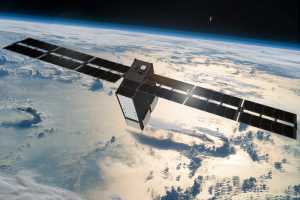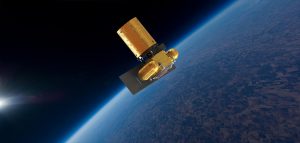
Over the past 12 months, we have heard a lot about it. It is being discussed at conferences, throughout exhibition halls, in the press and throughout the space industry at large. It is NewSpace. But what is it? SpaceWatch Middle East contributing editor Helen Jameson, gives her take on NewSpace; Defining a New Space Era.
What is NewSpace? Is it simply a new phase in the industry – a new space era? At this point in time, it is very difficult to define, but it is resulting in the rapid emergence of forward-thinking, boundary-pushing companies that are focused on the democratisation and commercialisation of space. It is a disruptive force and it is enormously exciting for anyone who watches the space industry.
Space is no longer the preserve of governments and private companies backed by billions. It is literally being opened up to those prepared to be part of it. Talented engineers that, in the past, have found themselves with great vision, but not enough money, can now actually seriously look at making their space dream a reality. They can set up crowd funding schemes so that like-minded people can invest in their initiatives. They can pitch investors with their ground breaking ideas. Silicon Valley is the new Hollywood.
The space industry is different to the industry it was just five years ago. Something has happened that has re-invigorated it. Up until fairly recently, players were discussing how the industry needed to remain relevant, how it must innovate or die. Then, HTS happened along with the use of different orbits. Very suddenly, a slew of LEO space companies have burst onto the scene. Today, we look at the industry and marvel at the fact that it is in the midst of a true renaissance.
There is a new awareness about space – and that doesn’t mean just within the industry itself, but on a global scale and in terms of the average Joe you meet in the street. People are aware but more importantly, they are interested. Talk of a lunar base and a settlement on Mars, interplanetary exploration and making space work for us holds fascination for majority of people.
Space is incredible. It’s a mystery. And it’s where our future lies. But it’s also more fundamental than that. Space connects us. It enables us to communicate – a fundamental need. There is a realisation from governments that a space programme, even for developing nations, can create socio-economic development. It can bring education, health and prosperity. This is an awakening and it is all feeding into what we are calling NewSpace today.
Inspiration for this NewSpace ‘movement’ (if that is what you would like to call it) has come from role models that are synonymous with entrepreneurship. Elon Musk, Jeff Bezos and Sir Richard Branson, James Cameron, James Bigelow, Greg Wyler are pioneers of the private space business. Their enthusiasm, drive and vision to push to the next level in space is infectious, and it is literally sweeping people along, encouraging all important investment. This space game is not cheap. Announcements of mega constellations, some comprising thousands of small satellites, seem to be the order of the day, and it will certainly be very interesting to see which ones will make it.
However, there is another side to New Space which is even more dynamic. It is the start-up companies that are now daring to make their dreams reality. There are investors who want to put their money where their mouth is and get engaged in something that involves space. Space is sexy, and that attracts the cash. Despite the interest, start-ups have a long journey ahead and many won’t make it. With rounds of funding ahead, it is a difficult and all-consuming task. They may not have a big name to attract the press and multi-million dollar investors, but they are quietly working away and making their own difference to the space business, helping to push on to the next frontier.
 The Small Satellite Revolution
The Small Satellite Revolution
Small satellites are playing a significant part in the NewSpace phenomenon. Originally associated with the scientific and Earth observation communities, smallsats are rapidly evolving as their capabilities and strengths are becoming apparent to the commercial space community.
Small satellites are quick to manufacture, cutting lead times significantly. Being small, they are also much cheaper to get to orbit. They are fast to manufacture, meaning that new technology can easily be demonstrated within short timeframes and perhaps most importantly, small satellites are proving to be just as capable as their monolithic brothers. The small satellite market is set to explode.
In a 2016 report, NSR’s Small Satellite Markets, 3rd Edition, it was forecast that the market for 1-100kg satellites will more than double to reach 375 satellites launched per year with the market driven by commercial and government constellations. This is set to create ongoing demand for manufacturing and launch services. However, it is the launch industry that must keep up with the sector’s growth. Carolyn Belle, author of the report stated: “Launch remains the single most significant bottleneck to smallsat market expansion. Traditional and dedicated rideshares will continue to be the main route to space, but the dependence of commercial success on the timely deployment of tens of satellites in unique orbits mean that delay of more suitable launch options will impede market development.”
The other big issue for the smallsat market is Space Situational Awareness (SSA) and a general lack of knowledge within the smallsat sector about orbital parameters. With so many small satellites in the pipeline for launch, careful attention will have to be paid to where each satellite will orbit. With such crowded skies, there is a much higher risk of something going badly wrong and it is up to the small satellite operators to work closely with the International Telecommunications Union (ITU) to make sure these scenarios are not allowed to play out. It appears that the awareness of these issues, and the processes that must be gone through to avoid them, comes far too late in the process of bringing the satellite to launch. This already is a much shorter timeframe than development of a traditional satellite. This is especially crucial for small satellites because they have no propulsion, and therefore, no orbital control.
That said, the small satellite market is open to some extremely innovative applications such as Big Data and asteroid prospecting and the sector is building up a considerable community in terms of manufacturers, dedicated launchers, communications and how the data is actually processed and analysed. However, with so many small satellites being lofted, a very careful approach to spectrum and SSA is required in order to prevent anything going wrong.

Asteroid Prospecting and Mining
The concept of asteroid mining is going through a rapid development. Using spacecraft to prospect and mine asteroids in near space is very much part of the NewSpace era and is an intriguing and growing industry. We are well on the way to exhausting planet Earth’s resources. We are fast running out of precious metals and minerals and we could potentially be looking at a situation where we have only 50-60 years of resources left. Space appears to offer rich rewards for those that are prepared to go and look for resources in space, and asteroids, that are known to have deposited large amounts of their rich materials on Earth over the millennia, are a logical starting point.
Asteroids are rich in minerals and other metals such as gold, silver, platinum, iridium, osmium, palladium, rhenium, tungsten and ruthenium along with substances and gases such as water, ammonia, hydrogen and oxygen. The exploitation of asteroids means that these raw materials could either be used in space to help sustain astronauts for example, or even provide rocket propellant for spacecraft to continue their journey. The other option is to return asteroid material back to Earth for use. However, other options are being discussed that would involve transporting the asteroid to a safe orbit around the moon, Earth or even to the ISS to allow the majority of the materials to be used and not wasted.
With Luxembourg well emerged as the hub for asteroid mining companies, this is a particularly interesting sector and with companies promising demonstration missions as soon as later this year, it’s going to be one to watch.

Launch Market
We can’t talk about New Space without talking about the launch sector. There was a time when the space industry talked about much-needed competition in the launch market. Today, there are many launch vehicles in development. This is a hugely vibrant market which was re-invigorated by SpaceX, paving the way for lower cost access to space and continued innovation in the sector – and going way beyond where was thought possible. SpaceX and Jeff Bezo’s Blue Origin have made the reusable rocket concept a reality. Launch vehicle providers have very ambitious plans and development of suborbital vehicles as well as interplanetary ones, will be critical. After all, without a vehicle to get us there, how will mankind ever achieve what it wants to in space?
We have already talked here about the smallsat market, and this is set to spur growth and development in the launch sector. It will need to develop and grow further to literally keep up with the pace of development in small satellites.
Pioneering Spirit
There is so much to cover in terms of what NewSpace is – and it is a term that is very much debated and in a state of flux. Yes, it’s cheaper, easier access to space but it’s so many other things as well. This new awareness and motivation can encourage capacity building and bring together a NewSpace community and ecosystem dedicated to making these project a reality.
Think about what mankind has achieved. Think about where we are and the technology that we have developed from nothing. NewSpace is a renewed pioneering spirit that is once again pushing us forward. It is a new era, a realisation that to progress, we have to go where we have not gone before. And today, it is within our reach. Barriers to entry are being brought down and new markets created – and we should be very proud and honoured that we are able to be party to these developments.
New Space: SpaceWatch Middle East’s Ones to Watch
Planet designs, builds and launches satellites faster than any company or government in history. Using commodity consumer electronics, the Company builds highly capable satellites at drastically lower costs. With the most advanced satellites launching into orbit every 3-4 months, Planet’s capabilities are on the cutting edge and always advancing. Planet offers its solutions to many different sectors including agriculture, defence and intelligence, mapping, energy and infrastructure and forestry.
Clydespace is the award-winning Scottish SME focused on the design and manufacture of hardware for cubesats, smallsats and nanosats. The company supports missions of all levels from the conceptual design to the development, integration, testing and through to launch and on-orbit operations. Clydespace offers two types of satellite design – off-the-shelf and bespoke.
Clydespace’s rise has been impressive. Today, the company is the second prime contractor in UK having developed an end-to-end capability but it is the number one company in the world for cubesats. 40 percent of all cubesat missions are supported by Clydespace.
GOMSpace is headquartered in Denmark and began as a start-up for academic and small satellite missions but has since experienced a meteoric rise to prominence. The company quickly started to take on increasingly complex missions and is now engaged in the global market for space systems and services by introducing new products, i.e. components, platforms and systems based on innovation within professional nanosatellites. Last year, the company started trading on the Stockholm Stock Exchange.
GomSpace was established in 2007 by three students from Aalborg University (AAU). GomSpace counts today more than 40 employees in its staff and presents a long list of customers on a global scene, including amongst other NASA, ESA, the Danish Defense, commercial customers and universities in 35 countries. GomSpace has participated in more than 40 satellite missions and accomplished no less than two successful missions with its own satellites, including the GOMX-3 satellite, which went into orbit last year with first Dane in space, Andreas Mogensen.
Berlin-based PTScientists are engaged in a pioneering mission to become the first private company to go to the Moon. The Company plan to launch 14.5 day mission to the site where humanity last set foot on the Moon and is developing and test driving new technologies to lead the way for a future of prolonged space exploration.
The PTScientists team is completely independent of governments and political ambitions, and the goal is to offer an economical solution for lunar and space research and development. The team hopes this will allow more people to conduct novel research and bring space activity into new markets.
PTScientists will launch a spacecraft next year, containing two lunar rovers, on board a SpaceX Falcon 9.
ALINA is the team’s first private spacecraft, built to transport the two rovers to the Moon and land them safely on the lunar surface. ALINA is capable of travelling the 380,000Km distance from Earth to the Moon and can deliver up to 100Kg to the surface of the Moon. The team has partnered with Audi to develop the lunar rovers, which are packed with sensors and equipped with HD cameras. PTScientists is also working with Vodafone to deliver the first mobile data (4G LTE) base-station to the lunar surface.
https://youtu.be/4hNa8uiNdR8
NewSpace – Defining a New Space Era ?! SpaceWatch Middle East will be on it!
Original published at: https://spacewatch.global/2017/03/spacewatchme-oped-defining-new-space-era/
 SpaceWatch.Global An independent perspective on space
SpaceWatch.Global An independent perspective on space





